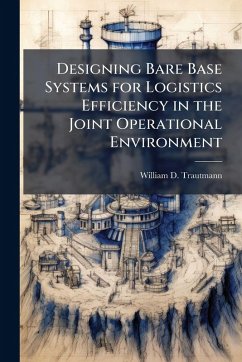
Deployment Logistics and the Impact of Seabasing

PAYBACK Punkte
8 °P sammeln!
Deployment is one of the hardest and most critical logistical tasks. Since WWII, the development of distribution methods to overcome logistics issues has continued with mixed success. This monograph explores these issues and the methods used to mitigate them in a case study format. The three case studies used are WWII through the end of the Cold War, Operation Desert Storm and Operation Iraqi Freedom. The findings of the case studies are that attempts to mitigate issues in logistics fail to address the entire distribution network. The methods discussed are the land-base concept (basing), Joint...
Deployment is one of the hardest and most critical logistical tasks. Since WWII, the development of distribution methods to overcome logistics issues has continued with mixed success. This monograph explores these issues and the methods used to mitigate them in a case study format. The three case studies used are WWII through the end of the Cold War, Operation Desert Storm and Operation Iraqi Freedom. The findings of the case studies are that attempts to mitigate issues in logistics fail to address the entire distribution network. The methods discussed are the land-base concept (basing), Joint Logistics Over-The-Shore (JLOTS), regular transportation by either air or sea (bulk shipping), Prepositioning (PREPO), Joint Task Force Port Opening (JTF-PO), and the sea-base concept (Seabasing). Improvements made to one method hinder the success of other methods and fail to address the true problems of early entry command and control, visibility and capability issues that exist in the distribution process. The conclusion of this analysis is the recommendation of continued integration of the distribution process, specifically the integration and synchronization of the six methods of deployment in light of the command and control, visibility and capability issues and the need to maintain this focus when confronting concepts like seabasing and direct delivery. This paper articulates an analysis, solution and recommendation of the way forward by seabasing the command and control of logistics forces. This work has been selected by scholars as being culturally important, and is part of the knowledge base of civilization as we know it. This work was reproduced from the original artifact, and remains as true to the original work as possible. Therefore, you will see the original copyright references, library stamps (as most of these works have been housed in our most important libraries around the world), and other notations in the work. This work is in the public domain in the United States of America, and possibly other nations. Within the United States, you may freely copy and distribute this work, as no entity (individual or corporate) has a copyright on the body of the work. As a reproduction of a historical artifact, this work may contain missing or blurred pages, poor pictures, errant marks, etc. Scholars believe, and we concur, that this work is important enough to be preserved, reproduced, and made generally available to the public. We appreciate your support of the preservation process, and thank you for being an important part of keeping this knowledge alive and relevant.












